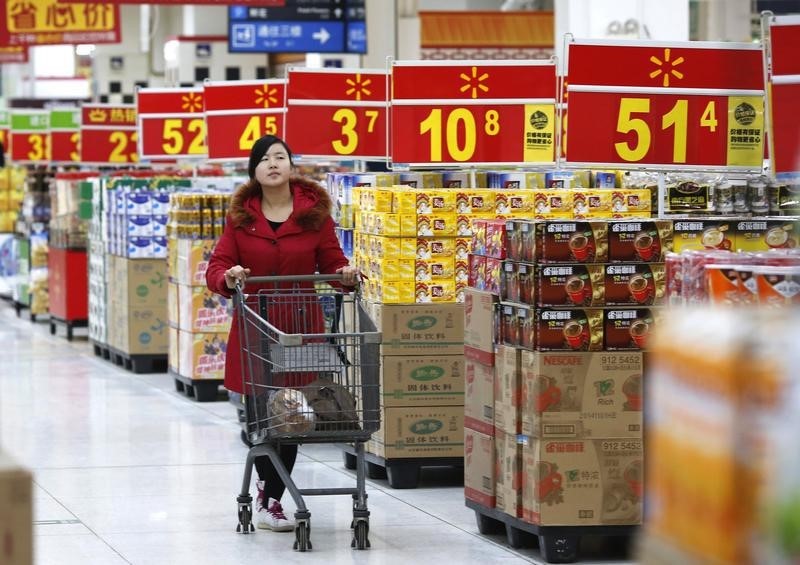By Adam Jourdan
SHANGHAI (Reuters) - A rare glimpse at figures for a number of Wal-Mart Stores Inc's (N:WMT) China outlets shows sales slid 6 percent last year, casting a shadow over the firm's target for China to account for a quarter of its global retail growth over the next five years.
The U.S. retail giant doesn't break out its China store sales, but a local joint venture partner submitted filings with the data to a Chinese asset exchange platform as part of a planned sale of minority stakes in 21 Walmart stores. Wal-Mart had 415 China stores at the end of August.
Combined revenue at those 21 stores fell 6 percent to 26.6 billion yuan ($4.2 billion), the data show, illustrating Wal-Mart's challenge to drive sales growth in the world's second-largest economy, where retailers are under pressure from a cooling economy and the rise of shopping online.
International firms from luxury brands such as LVMH (PA:LVMH) and Burberry (L:BRBY) to global auto makers, are feeling the pinch as China's consumers tighten their belts.
The data, released in filings from a unit of state-backed conglomerate China Resources Corp (CRC), show no obvious single factor impacting performance at the stores, which vary in size and age. The 21 stores, located across China from Beijing to far-western Sichuan, employ some 30,000 staff, including more than 20,000 at a single outlet in the southern city of Shenzhen. Wal-Mart says it has more than 100,000 employees in China.
Wal-Mart CEO Doug McMillon this week acknowledged China was a "bit tough", but the world's largest retailer by revenue maintains that in the long-term China is an "exciting, dynamic, large and competitive market".
"As the middle class continues to grow we see an incredible opportunity and we have been putting the pieces in place," McMillon said on an investor call on Wednesday.
Wal-Mart plans to grow its China footprint by nearly a third with around 115 new stores to open by 2017.
In August, Wal-Mart said comparative sales in China dipped 1.4 pct in May-July.
TEMPERATURE CHECK
To be sure, the Chinese filings provide only a temperature check on part of Wal-Mart's China business, but analysts said the stores' combined sales slide was still a worrying sign. The filings, posted on the Shanghai United Assets and Equity Exchange, show 18 of the 21 stores saw sales decline last year.
"If on average across these 21 stores there's a 6 percent drop, that's more than you'd expect," said Torsten Stocker, Hong Kong-based retail analyst with AT Kearney. "They've previously never really released China-specific data so it may well be concerning them. If I was in their shoes I'd be a bit worried."
He noted the data covers only a small selection of Wal-Mart's China stores, adding: "It fits the story that the last couple of years have been pretty tough. It's still a very difficult environment for foreign retailers."
A Wal-Mart spokeswoman declined to comment beyond an earlier statement saying the firm respected the "investment decision" of its joint venture partner. China Resources, which is seeking more than $500 million for the stake in the stores, did not respond to queries about why it was looking to sell, though it does have other retail interests including a venture with Britain's Tesco PLC (L:TSCO).
Bentonville, Arkansas-based Wal-Mart slashed its global outlook on Wednesday for the next fiscal year, sparking the steepest one-day drop in the company's shares in a quarter of a century.
TOUGH ROAD AHEAD
The China filings show debt levels at the 21 stores have also risen, with total liabilities equal to around 80 percent of total assets as of end-May, up from 76 percent in 2013. Profits and margins, however, improved over that period, signaling a successful drive to rein in costs.
China's food retail market has been cooling, while local rivals have eaten away at international firms' market share, according to market research firm CTR China. The market grew at 3.4 percent in the second quarter, down from closer to 10 percent in early 2013.
This has seen Wal-Mart, France's Carrefour (PA:CARR) and Tesco all see sales growth slip, with average same-store sales growth dropping into negative territory last year, according to consultancy OC&C.
"The ability of Western retailers to really compete in China isn't going to get any easier. Some advantages they had for a number of years - branding, supply chain, back office - the local guys are catching up on that," said AT Kearney's Stocker.
Wal-Mart has been beefing up its online presence in China to counter slowing growth offline, buying out e-commerce firm Yihaodian.com in July.

($1 = 6.3545 Chinese yuan renminbi)